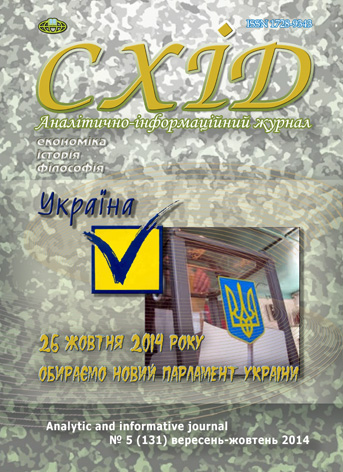The overview of the technosphere's development through the evolutionary theory of Charles Darwin
DOI:
https://doi.org/10.21847/1728-9343.2014.5(131).29618Keywords:
evolutionary theory, meme, gene, idea, creative design, meme-poolAbstract
This article is devoted to overview the role of the human mind in the formation of the technosphere through the evolutionary theory of Charles Darwin. This paper compares Charles Darwin's evolutionary theory with the process of cultural formation, the biological world with the world of ideas. The author tries to show this identity by identifying mechanisms involved in the development of technological artifacts. Special attention is paid to the conception of the formation so-called "memes" - units of cultural information.
In this article we tried to show that the idea of creative design can be replaced by an alternative theory of evolutionary development. As a result of certain inferences the author came to the following conclusions: first of all, the background of evolutionary theory are not exclusive to the biological world, and therefore it can be applied to other areas of reality.Memes (in other words ideas) developed by analogy with the genes. Thechnology device, such as a wrist watch is a collection of memes, which evolved throughout the history of mankind.
People's mind is full of memes, which are competing for resources. The most effective memes are those that have the ability of self - reproduction. Thus, in the case of a wristwatch, we can assume that design thinking was correlated with memes that were specific to earlier versions of watcht mechanism. Some of those memes, were very well represented, and in the result was included in the design wristwatch modern example. Memes that were not so effective (for example, the idea of attaching hours in the jacket with chains) were not included in the new design and now almost extinct. Transmission of memes for thousands of years has led to the invention of modern wristwatches. It was only a matter of time before they are all concentrated in one mind of the inventor, and finally a modern version of a wristwatch was born.
If the assumptions that we have made are right, and if evolutionary theory also will pass the test of time, it is quite possible that the idea of creative human creativity in the history of technology can be replaced by the concept mimetic evolution.Downloads
References
Hartig E. F. (1828), Die Forst-Betriebs Einrichtung nach staatswirthschaftlichen Grundsätzen, Cassel (ger).
Hartig E. F. (1826), Anweisung zur Aufstellung und Ausführung der jährlichen Forstwirthschaftsplane nach Maßgabe einer systematischen Forstbetriebs-Einrichtung, Giessen (ger).
Hartig E. F. (1827), Praktische anleitung zum baumroden nach den neuesten versuchen, Marburg, available at: http://books.google.com.au/books?id=yE0DAAAAYAAJ&printsec=frontcover&hl=ru&source=gbs_ge_summary_r&cad=0#v=onepage&q&f=false (ger).
Hartig E. F. (1828), Praktische Anleitung zum Vermessen und Chartiren die Forst und Bezug auf Betriebs-Regulirung, Frankfurt am Main (ger).
Hartig E. F. (1831), Lehrbuch der Teichwirthschaft und Verwaltung in Verbindung mit der Wiesen- und Ackerverbesserung nach den Anforderungen des rationellen Landwirthes, Cassel (ger).
Beckman I. "Introduction to the technology, or the knowledge of plants, factories and manufactories", available at: http://vikent.ru/author/1888/ (rus).
Engelmeier P. (1915), Defending the common ideas in engineering, Moscow (rus).
Engelmeier P. (1912), Car. Motosiklet. Motor boat, Moscow (rus).
Engelmeier P. (1897), Invention and privileges, Moscow (rus).
Engelmeier P. (1911), Guide to privilegirovanniy inventions, St Petersburg (rus).
Engelmeier P. (1910), Theory of creativity, St Petersburg (rus).
Pavlenko A. (2007), The possibility of technology. Part 3. Technical project Friedrich Dessauer, History of philosophy Yearbook, pp. 325-351, available at: http://iph.ras.ru/page50065310.htm.
Haidegger M. (1989), Being and time, Tbilisi (rus).
Heidegger M. (1991), Conversation on a country road: Selected papers of the late period of creativity, Moscow (rus).
Heidegger, M. (1993), Вeing and Time: Articles and speeches, Moscow, 447 р. (rus).
Jasper K. (1991), The origin and goal of history, Politizdat, Moscow, 527 p. (rus).
Gaidenko P. P. (1991), People and history in existential philosophy Karl Jaspers, Moscow (rus).
Mumford L. (2001), The myth of the machine. Technics and human development, Moscow (rus).
Berdyaev N. Experience the eschatological metaphysics. Creativity and the objectification, available at: http://gtmarket.ru/laboratory/basis/311. (rus).
Blackmore, Susan (1999), The Meme Machine. Oxford University Press (engl).
Darwin, Charles (1859), On The Origin of Species by Means of Natural Selection, London (engl).
Dawkins, Richard (1976), The Selfish Gene, Oxford University Press, Oxford (engl).
Dawkins, Richard. (1986). The Blind Watchmaker, Longmans, London (engl).
Dennett, Daniel C. (1995), Darwin's Dangerous Idea, Penguin Books (engl).
Dennet, Daniel C. (1999), The Evolution of Culture, available at: http://www.edge.org/documents/archive/edge52.html (engl).
Silby, Brent (2000), Revealing the Language of Thought, available at: http://www.def-logic.com/articles/Reveal Language оf Thought. html (engl).
Downloads
Published
How to Cite
Issue
Section
License
Copyright (c) 2014 Olga Alieva

This work is licensed under a Creative Commons Attribution-NonCommercial-NoDerivatives 4.0 International License.
1. Authors bear responsibility for the accuracy of facts, quotations, numbers and names used.
2. Manuscripts are not sent back.
3. The publisher does not always agree with the authors' opinion.
4. The authors reserve the right to authorship of the work and pass the first publication right of this work to the journal under the terms of a Creative Commons Attribution-NonCommercial-NoDerivatives 4.0 International License. This license allows others to distribute (copy) the published work for non-commercial purposes, provided there is mandatory attribution to its authors and a link to the first publication in our journal.
5. The authors have the right to conclude separate supplement agreements that relate to non-exclusive work distribution in the form in which it has been published by the journal (for example, to upload the work to the online storage of the journal or publish it as part of a monograph), provided that the reference to the first publication of the work in this journal is included.

